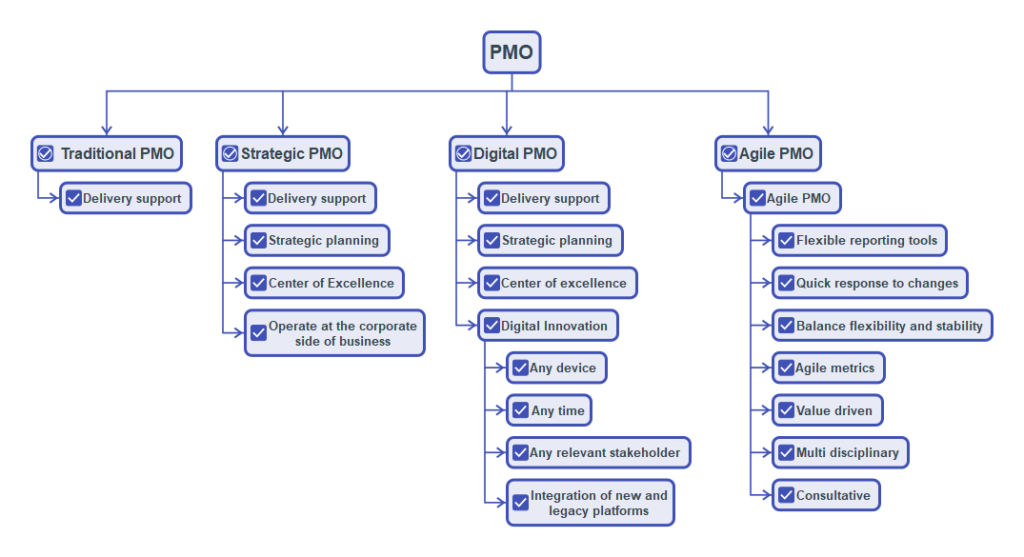PMOs are evolving at a faster pace than anticipated. The traditional PMO’s started by providing project delivery support. Soon PMOs became strategic in nature by extending their support to enterprise portfolio management. This was followed by the digital PMO and the Agile PMO.
The future is of ‘Digitally agile PMOs’, which will help the project managers and other key stakeholders to be more agile and predictive at the same time. Facilitating the adoption of agility along with the predictability of the predictive project management.
Here is a mind map on the evolution of PMOs through traditional, strategic, digital and agile to ‘Digitally agile PMO’

Characteristics of digitally agile PMO
- Multi disciplinary – They are multi disciplinary. They must be able to support projects in all the aspects of project management covering;
- Scope
- Schedule
- Cost
- Resources
- Procurement
- Communications
- Stakeholders
- Quality
- Risks
- Integration
- Value driven – Their primary focus is to maximize the value delivered to the customer in the shortest possible time. They must also enforce a minimum set of ground rules to facilitate effective collaboration.
- Agile metrics – Apart from the traditional metrics, they focus on the agile metrics. Most of the predictive project management metrics and measurements are focused on the past performance like schedule variance, cost variance etc, where as the agile metrics combine both past and future indicators.
- Balance flexibility & stability – While scope is flexible, other parameters like time buckets, rules of credit, definition of done (acceptance criteria) must remain non-negotiable and must be uniform across projects.
- Quick response to changes – As agile projects welcome changes even late in the project, agile PMOs should also align to this character of agile projects.
- Flexible reporting tools
- Iteration burn downs
- Release burn downs
- Product burn downs
- EVM for agile
- Cumulative flow diagrams
- Schedule forecasts
- Cost forecasts
- Multi device
- Any device
- Any time
- Any relevant stakeholder
- Integration of new and legacy platforms
Benefits from a ‘digitally agile’ approach to project management
Scenario
- Project with tight schedule with penalty clause
- Multi cultural team with team members from USA and China
- Concurrent engineering from 6 different locations
Strategy
- Hybrid project management, mixing the best of both agile and predictive best practices. The long term planning was based on the predictive styles where as for execution the best practices of agile were used
- Right selection of a project monitoring and control tool with the capability to;
- Support both predictive and agile ways of working
- Provide transparency and accuracy of project progress data to relevant stakeholders almost real time
- Interface with legacy scheduling and document management systems
- Roll up and roll down project status from multiple locations
- Manage risks
- Manage quality
- Manage configuration management of engineering drawings
- Collaborate across multiple teams
Benefits
- Project got completed ahead of schedule
- 85% improvement in project management efficiency
- 75% less time in reporting
- 100% quality achievement
- 80% reduction in deliverable management time
- Reduction in review cycle time from 7 days to 1 day
To know more contact us
